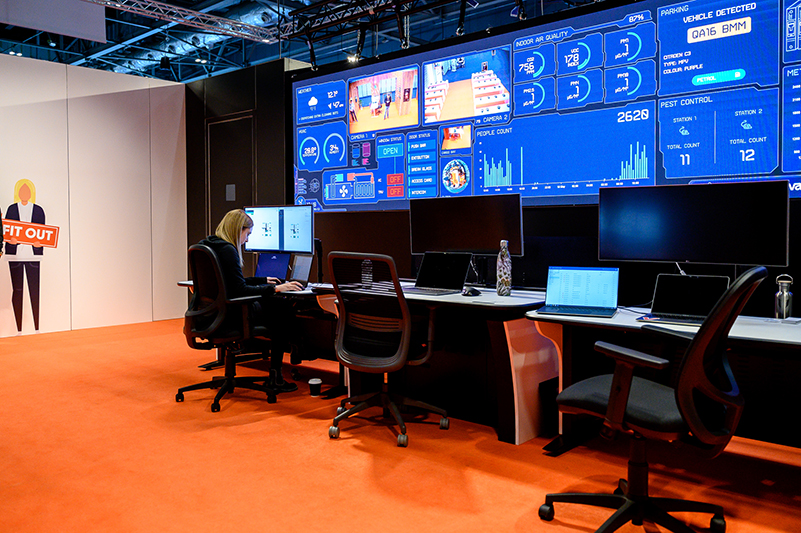The relationship between facilities management (FM) and security is complex. Both sectors are reliant on the other, but the two sides often struggle to see eye-to-eye. With three speakers from different backgrounds, a panel session at IFSEC in May explored whether shared challenges can bring these two areas closer together.
Speakers for the session:
- Tom Ward, Senior Account Director, Anabas
- Lee Odess, Access Control Influencer
- Kieran Mackie, Managing Director, Amulet
Panel chair Tom Ward’s 30-year career – which has seen him manage contracts with the BBC, Sellafield and Rolls-Royce – provided the ideal steer for a discussion on how the gap between FM and security can be bridged.
The impact of covid
There’s no doubt that security trends have shifted since the pandemic. Over time, we’re understanding that making a building secure means that more people will come back to the office.
Providing “safe and secure environments that make people feel relaxed will be important,” according to Kieran Mackie, who specialises in security management.
Lee Odess, known as a go-to voice for the access control industry, expanded on this point: “Keeping bad people out has been a priority for a long time. Coming out of the pandemic everyone was a visitor. Now, there’s more pressure on adding value and letting the right people in,” he said.
Digital transformation vs human interaction
With digital transformation and enterprise software dominating the sector, the panel talked about the impact of this trend on access control systems. There’s an expectation that people can do everything with their phones; from gaining access to their place of work to buying coffee.

The Smart Building Experience at FAC & IFSEC 2023 – where facilities management and security meet
However, Odess offered a note of caution on this point: “If people don’t feel safe they won’t go in a building – I don’t care how good the lattes are. The experience side of our sector challenges a lot of the conventional wisdom,” he explained.
The value of the softer side of security was one of the key takeaways of the session, with visitors to a building expecting a customer service element from security professionals. However, the human element of security still serves to mitigate risk, as the power of a simple ‘hello’ has been proven to disrupt those with malicious intent.
The ‘Apple Wallet’ experience
Circling back to sector trends, the panel referenced the recent work at 22 Bishopsgate in London – hailed as one of the first Apple wallet experience buildings in the UK.
Serving as a perfect example of the balance between security and convenience, Odess added: “I believe you’ll start to see more of this kind of rollout. You can go from house to tube and never take a key.” Indeed, the consensus in the room was that the smartphone is now an extension of the hand.
But what other themes are prominent now? At an operational level, security companies are moving more into advisory roles.
Mackie explained that as a guarding provider, clients would traditionally expect to provide the technology. But the end goal must be to create a safe environment; not to “buy five things and stitch them together,” he said.
The speakers agreed that we need to think about security as a whole. Whether it’s CCTV, access control, guarding, or a blend of other solutions, the focus should be on keeping people safe.
Minding the skills gap
The well-publicised skills gap in the security sector was touched upon towards the end of the session.
Recently, Odess had spoken to 80 graduates at a top university in his native America. No hands were raised when he asked them whether they were considering the security sector. He suggested that blending technology with the human side of security – with AI as an example – presents an opportunity to attract new talent.
READ: Peter French and filling the digital skills gap
New technology
With AI as a talking point, the conversation broadened to consider the place of robotic technology. Mackie suggested that they have their place, but robotic dogs can feel a bit “gimmicky” in terms of what they can achieve. “Is this kind of technology any better than a camera on the wall?” he asked.
Odess offered a very practical example of where drones are adding value to a higher-risk site. Drones would be sent in first to look at the facility – then humans if it was deemed safe.
The panel concluded that this kind of technology is more of an enhancement of the human side of security and FM – rather than a replacement.
Specific threats and solutions
All three speakers agreed that there is no better time to work in security and FM, with Odess noting a shift in the market and a “higher level of curiosity” among his peers.
In conclusion, Ward offered some salient remarks for the future: “Anyone who buys security needs to look at their specific threats and how to mitigate these. What kind of risk tolerance does that then leave? As professionals, it’s our duty to then recommend a blend of the right solutions,” he said.
Hear more from Lee Odess on episode 11 of the IFSEC Insider Security in Focus podcast…

